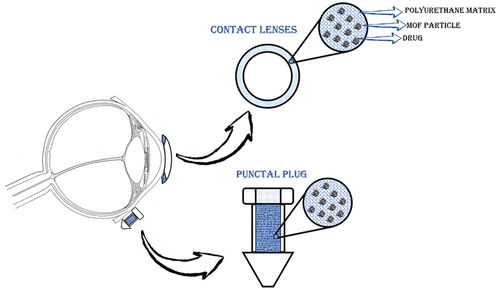当前位置:
X-MOL 学术
›
ACS Appl. Mater. Interfaces
›
论文详情
Our official English website, www.x-mol.net, welcomes your
feedback! (Note: you will need to create a separate account there.)
MOF-Based Polymeric Nanocomposite Films as Potential Materials for Drug Delivery Devices in Ocular Therapeutics.
ACS Applied Materials & Interfaces ( IF 8.3 ) Pub Date : 2020-06-12 , DOI: 10.1021/acsami.0c07517 J Gandara-Loe 1 , B E Souza 2 , A Missyul 3 , G Giraldo 4 , J-C Tan 2 , J Silvestre-Albero 1
ACS Applied Materials & Interfaces ( IF 8.3 ) Pub Date : 2020-06-12 , DOI: 10.1021/acsami.0c07517 J Gandara-Loe 1 , B E Souza 2 , A Missyul 3 , G Giraldo 4 , J-C Tan 2 , J Silvestre-Albero 1
Affiliation

|
Novel MOF-based polymer nanocomposite films were successfully prepared using Zr-based UiO-67 as a metal–organic framework (MOF) and polyurethane (PU) as a polymeric matrix. Synchrotron X-ray powder diffraction (SXRPD) analysis confirms the improved stability of the UiO-67 embedded nanocrystals, and scanning electron microscopy images confirm their homogeneous distribution (average crystal size ∼100–200 nm) within the 50 μm thick film. Accessibility to the inner porous structure of the embedded MOFs was completely suppressed for N2 at cryogenic temperatures. However, ethylene adsorption measurements at 25 °C confirm that at least 45% of the MOF crystals are fully accessible for gas-phase adsorption of nonpolar molecules. Although this partial blockage limits the adsorption performance of the embedded MOFs for ocular drugs (e.g., brimonidine tartrate) compared to the pure MOF, an almost 60-fold improvement in the adsorption capacity was observed for the PU matrix after incorporation of the UiO-67 nanocrystals. The UiO-67@PU nanocomposite exhibits a prolonged release of brimonidine (up to 14 days were quantified). Finally, the combined use of SXRPD, thermogravimetric analysis (TGA), and Fourier transform infrared (FTIR) analyses confirmed the presence of the drug in the nanocomposite film, the stability of the MOF framework and the drug upon loading, and the presence of brimonidine in an amorphous phase once adsorbed. These results open the gate toward the application of these polymeric nanocomposite films for drug delivery in ocular therapeutics, either as a component of a contact lens, in the composition of lacrimal stoppers (e.g., punctal plugs), or in subtenon inserts.
中文翻译:

基于MOF的聚合物纳米复合薄膜作为眼科治疗药物输送装置的潜在材料。
使用基于Zr的UiO-67作为金属-有机骨架(MOF)和聚氨酯(PU)作为聚合物基质,成功制备了基于MOF的新型聚合物纳米复合材料薄膜。同步加速器X射线粉末衍射(SXRPD)分析证实了UiO-67嵌入式纳米晶体的稳定性得到了改善,而扫描电子显微镜图像证实了它们在50μm厚膜中的均匀分布(平均晶体尺寸约100-200 nm)。N 2完全抑制了嵌入MOF内部多孔结构的可及性在低温下。但是,在25°C下的乙烯吸附测量结果证实,至少45%的MOF晶体可完全用于非极性分子的气相吸附。尽管与纯MOF相比,这种部分堵塞限制了嵌入式MOF对眼药(例如酒石酸溴莫尼定)的吸附性能,但在掺入UiO-67后,PU基质的吸附能力提高了近60倍纳米晶体。UiO-67 @ PU纳米复合材料表现出溴莫尼定的延长释放(量化长达14天)。最后,SXRPD,热重分析(TGA)和傅立叶变换红外(FTIR)分析的组合使用证实了纳米复合膜中存在该药物,MOF骨架和加载后该药物的稳定性,一旦吸附,溴莫尼定会以无定形相存在。这些结果打开了将这些聚合物纳米复合材料膜用于眼部治疗中的药物输送的大门,该膜可以作为隐形眼镜的组成部分,在泪腺塞子(例如泪点塞)的组合物中或在腱下插入物中使用。
更新日期:2020-06-12
中文翻译:

基于MOF的聚合物纳米复合薄膜作为眼科治疗药物输送装置的潜在材料。
使用基于Zr的UiO-67作为金属-有机骨架(MOF)和聚氨酯(PU)作为聚合物基质,成功制备了基于MOF的新型聚合物纳米复合材料薄膜。同步加速器X射线粉末衍射(SXRPD)分析证实了UiO-67嵌入式纳米晶体的稳定性得到了改善,而扫描电子显微镜图像证实了它们在50μm厚膜中的均匀分布(平均晶体尺寸约100-200 nm)。N 2完全抑制了嵌入MOF内部多孔结构的可及性在低温下。但是,在25°C下的乙烯吸附测量结果证实,至少45%的MOF晶体可完全用于非极性分子的气相吸附。尽管与纯MOF相比,这种部分堵塞限制了嵌入式MOF对眼药(例如酒石酸溴莫尼定)的吸附性能,但在掺入UiO-67后,PU基质的吸附能力提高了近60倍纳米晶体。UiO-67 @ PU纳米复合材料表现出溴莫尼定的延长释放(量化长达14天)。最后,SXRPD,热重分析(TGA)和傅立叶变换红外(FTIR)分析的组合使用证实了纳米复合膜中存在该药物,MOF骨架和加载后该药物的稳定性,一旦吸附,溴莫尼定会以无定形相存在。这些结果打开了将这些聚合物纳米复合材料膜用于眼部治疗中的药物输送的大门,该膜可以作为隐形眼镜的组成部分,在泪腺塞子(例如泪点塞)的组合物中或在腱下插入物中使用。











































 京公网安备 11010802027423号
京公网安备 11010802027423号